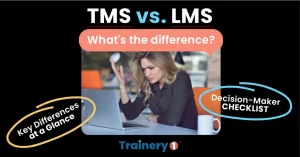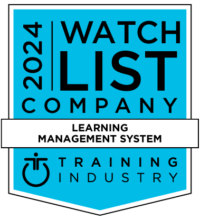Remote work has become the norm for many organizations and looks to remain so for the foreseeable future. But even though we’ve settled into a fairly routine work-from-home (or anywhere) way of life, meeting HR, safety, certification and regulatory compliance requirements can remain a significant challenge for organizations of all sizes. Posting notices in the break room and holding mandatory trainings in the conference room no longer works. Virtual work introduces new risks, like employees getting hurt while working at home with no environment controls.
To reduce compliance risks, many organizations are deploying eLearning solutions to deliver content, manage, and track employee learning and workforce training. Some cloud-based tools may also include automated tracking of compliance requirements and centralized license and certification management, including administration of OSHA, DOT, and DOL training requirements.
Here are six ways deploying the right content with the right technology can help organizations of any size improve workforce training and stay compliant with changing requirements and diverse workforce configurations.
- Create and train employees on your remote work policies.
Because most organizations were thrown unexpectedly into virtual work, it’s understandable that we were missing some relevant policies. If we’ve learned anything from the past year, it is to make sure that rules, procedures, and consequences are in writing, and, to deliver formal training on these new policies. Remote policies include everything from protecting sensitive data to displays of inappropriate material and acceptable attire on video calls to sexual harassment prevention policies. On-demand mobile learning platforms allow for consistent dissemination of information, economic delivery, and convenient training opportunities to increase user engagement and retention for remote, hybrid and/or mobile workforces.
- Expand your HR policy training.
In the ‘Before Times’, most companies had protocols in place around data compliance, use of approved software and devices, drug and alcohol policies, worksite safety, equipment utilization, emergency preparedness, etc. that worked well in an office environment. But these may be forgotten in the transition to work from home, especially with no one looking over employees’ shoulders to keep behavior or environmental conditions in check. With a robust learning management platform, Administrators can select and assign courses by need or by department, send automated reminders, and track completion within the desired timeframe. While it might not fully prevent violations, it at least gives you auditable proof of mitigation efforts to defend against any litigation.
- Stay compliant with dynamic requirements.
While many state and federal agencies have made temporary adjustments to rules or extended deadlines for compliance, they still require training to current standards. Many of these adaptations are continuing to change. Using compliance management technology is an easy, reliable method of staying on top of regulatory requirements, individual license and certification deadlines; and, to have signatory proof of attendance for onsite instructor led and individual training.
- Protect mobile privacy.
Thanks to the flexibility of virtual work, employees are no longer tied to their desks — they can participate in training wherever and whenever they have the opportunity. This means many are using personal devices and may be understandably reluctant to allow the installation of tracking software to monitor their work-related activities.
By deploying a Learning Management System (LMS) that offers a robust mobile platform, HR can deliver training to employees on any device, without overstepping privacy boundaries. The LMS provides the required compliance tracking, while employees can feel free to use their personal devices as they wish without having to worry about work-related software tracking their every move.
- Expand your safety training.
In the office, it’s much easier to provide a safe working environment when you have control over the facility, equipment and furniture. But at home, it’s not so easy. Some 40% of employees have new or increased pain in their neck, back and/or shoulders, likely due to poor ergonomics. If an employer provides office equipment—or even an equipment stipend—the company can be liable. OSHA has offered limited guidance, so it’s up to companies to supplement their existing safety training with specific work-from-home training to prevent accidents and ergonomic issues.
- Track mobility and local mandates.
With virtual work, employees can truly work from anywhere—their home a few blocks from the office, the beach house three states away, or on another continent. However, this flexibility means they may be subject to different compliance requirements than the office location, and employers are responsible for adhering to local mandates — an impossible feat without technology.
Studies show that over 90% of employees are fine with an employer tracking their location down to the city level, which is fully sufficient for local compliance. Therefore, one option is to deploy location tracking solutions built for global mobility that helps distributed workforce programs remain compliant with local mandates wherever they work. Paired with eLearning platforms, on-demand training technology can deliver employees the right information at the right time, regardless of — or specific to — their real-time location.
Remote work not only makes it more difficult to maintain training continuity but it also introduces new challenges unique to the virtual workforce that can complicate an already difficult job. Given the level of economic and reputation risk on the line, companies simply can’t afford noncompliance—but they also can’t afford not to offer the remote work flexibility and learning and development opportunities employees demand. Today’s learning technology can help employers better train a remote workforce, and track and maintain regulatory compliance without overstepping privacy concerns.







